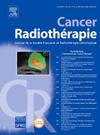少转移性头颈癌:引导患者轨迹和更广泛的影响
IF 1.4
4区 医学
Q4 ONCOLOGY
引用次数: 0
摘要
少转移性头颈部鳞状细胞癌是一种独特的临床状态,在目前的转移性疾病试验中没有得到充分的解决。这篇叙述性综述是基于历史文献和最近发表的Omet试验数据。Gortec 2014-04 Omet II期随机试验研究了头颈部鳞状细胞癌中真正的异时性少转移,其特征是有限数量(最多三个)病变不是由先前的全身治疗引起的,是否可以从单独使用治疗目的立体定向消融放疗的“降低升级策略”中获益,而不是依赖于预先的全身治疗策略。针对头颈部鳞状细胞癌的随机II-III期试验很少。在Omet试验中,两组患者的1年生存率均超过85%。正如预期的那样,化疗组和立体定向消融放疗组的无进展生存期略长(10个月对7.5个月),但对转移性复发没有有害影响。立体定向消融放疗单独显示明显较低的3-4级毒性(8.8%对60%)。单纯立体定向消融放疗患者的生活质量下降较少。不良预后因素包括男性和多发性转移。主要的方案偏差与较差的结果相关。立体定向消融放疗为真正的少转移性头颈部鳞状细胞癌的全身治疗提供了一种可行的、毒性更低的替代方案,需要精确的患者选择和进一步的研究。尽管免疫治疗作为一种新的治疗标准,但其在低转移性头颈部鳞状细胞癌中的作用仍不确定,需要对低转移性头颈部鳞状细胞癌进行特定的研究来挑战这一新的选择。本文章由计算机程序翻译,如有差异,请以英文原文为准。
Oligometastatic head and neck cancer: Navigating patient trajectories and broader implications
Oligometastatic head and neck squamous cell carcinoma is a distinct clinical state inadequately addressed in current metastatic disease trials. This narrative review is based on historical literature and recently published data of the Omet trial. The Gortec 2014-04 Omet phase II randomized trial investigated whether genuine metachronous oligometastases in head and neck squamous cell carcinoma, characterized by a limited number (up to three) of lesions not induced by prior systemic therapy, may benefit from a “de-escalation strategy” using curative-intent stereotactic ablative radiotherapy alone rather than strategies relying on systemic treatments upfront. Randomized phase II-III trials are scarce on head and neck squamous cell carcinoma. In the Omet trial, survival at 1 year exceeded 85 % in both arms. Progression-free survival was, as anticipated, slightly longer in the group chemotherapy and stereotactic ablative radiotherapy (10 months versus 7.5 months) but without deleterious impact upon metastatic relapse. Stereotactic ablative radiotherapy alone showed significantly lower grade 3–4 toxicity (8.8 % versus 60 %). Quality of life declined less with stereotactic ablative radiotherapy alone. Poor prognostic factors included male sex and multiple metastases. Major protocol deviations correlated with worse outcomes. Stereotactic ablative radiotherapy offers a viable, less toxic alternative to systemic therapy for genuine oligometastatic head and neck squamous cell carcinoma, warranting refined patient selection and further research. Despite its role as a new standard-of-care, the role of immunotherapy remains uncertain in the oligometastatic setting and requires specific studies in oligometastatic head and neck squamous cell carcinoma to challenge this new option.
求助全文
通过发布文献求助,成功后即可免费获取论文全文。
去求助
来源期刊

Cancer Radiotherapie
医学-核医学
CiteScore
2.20
自引率
23.10%
发文量
129
审稿时长
63 days
期刊介绍:
Cancer/radiothérapie se veut d''abord et avant tout un organe francophone de publication des travaux de recherche en radiothérapie. La revue a pour objectif de diffuser les informations majeures sur les travaux de recherche en cancérologie et tout ce qui touche de près ou de loin au traitement du cancer par les radiations : technologie, radiophysique, radiobiologie et radiothérapie clinique.
 求助内容:
求助内容: 应助结果提醒方式:
应助结果提醒方式:


